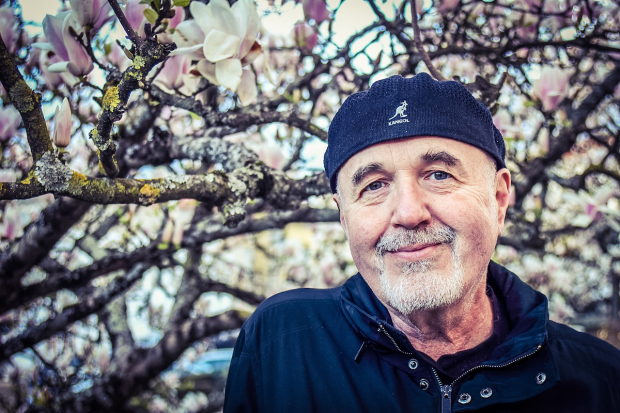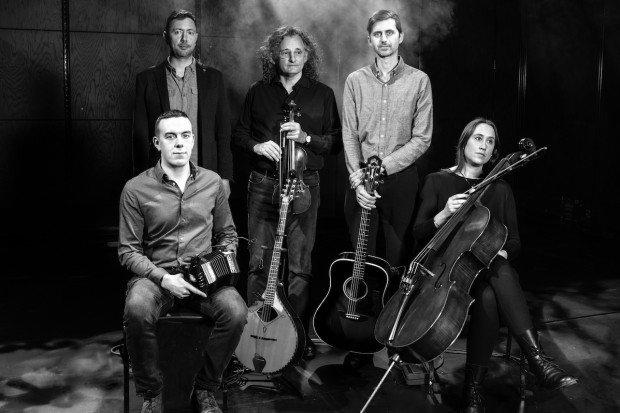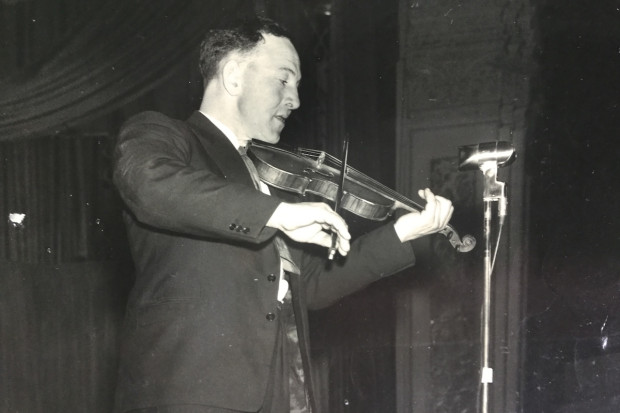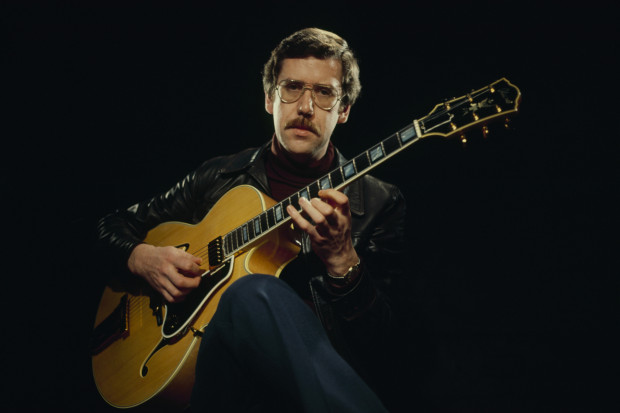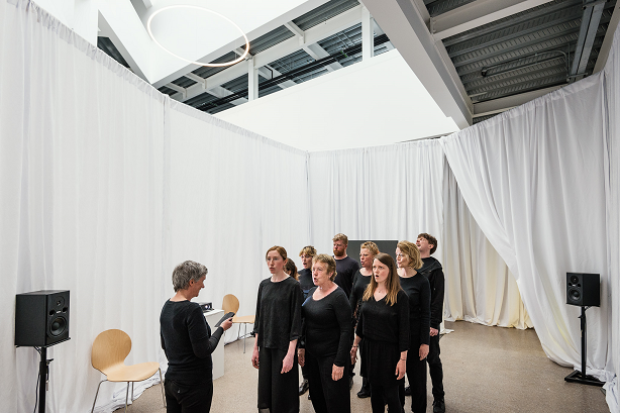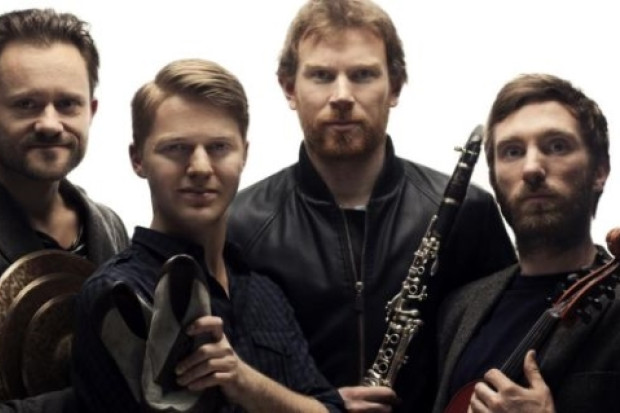
Martin Hayes and the New Irish Jazz Orchestra (Photo: Dublin Jazz Photography)
An Exchange in the Truest Sense
Described by Paul Dunlea as an experiment, this concert presented what the New Irish Jazz Orchestra leader described as a meeting between some of the best jazz musicians in Ireland and one of the country’s finest traditional musicians. Of course, the worlds of big band jazz and traditional Irish music are no longer so far removed as to render this a total leap into the unknown. Fiddle-player Martin Hayes has enjoyed musical encounters with a variety of musical genres while maintaining the sweetness of his tunes. An avowed fan of jazz, he has shared a stage with no less a boundary pusher than guitarist Bill Frisell. And the most recent edition of the Cork Jazz Festival saw uilleann piper Flaithrí Neff sit seamlessly in with multi-genre big band Bansangu Orchestra for a couple of tunes.
Even so, the genesis for this meeting of musical minds was somewhat opportunistic. Attending a wedding in a Cork hotel last November, Dunlea spotted Hayes relaxing in the bar after playing earlier that evening with Steve Cooney at Live at St Luke’s. He approached the Clare man and the idea of a collaboration was proposed.
Inner Urge
Aside from what Hayes and Dunlea were going to cook up there is also the matter of the New Irish Jazz Orchestra’s remit as a platform for Ireland’s finest jazz improvising talent and new composers and arrangers. With little ceremony the band opened with an arrangement by Dunlea of the Joe Henderson standard ‘Inner Urge’. Blowing away the air of stuffiness that can be associated with big bands, it felt thrilling to note that the bandleader was still making his way to the lectern when the drummer began improvising. He was then joined by saxophonist Paul Booth, founder of the aforementioned Bansangu Orchestra, who began playing in a manner more aggressive than the original recording’s opening passage. Dunlea’s arrangement marshalled his 18-piece band of musicians through the blueprint laid down by Henderson’s stellar quartet.
Later on they tackled Slide Hampton’s boon for big bands ‘Slide’s Derangement’. With Ryan Quigley shining on trumpet, the song, which was originally recorded by Maynard Ferguson on the A Message from Newport album, is a fun ride awash with exultant big brass rushes. On a more contemporary note, trumpeter Steve Fishwick led the band through Eric Alexander’s ‘Little Lucas’.
Howya Folks
As well as a vehicle for big band material there is also room to support Irish composers. Opening with the nimble piano playing of Cormac McCarthy, the band played ‘Corner Tree’, an original composition of Dunlea’s that’s full of mellow cool yet not lacking in zip nor drama. It was also distinguished by a solo from South African saxophonist Chris Engle, who Dunlea introduced as the newest member of the Cork jazz scene. ‘Vital Signs’, written by trombonist Paul Frost, allowed space for Paul Byrne on drums, Dan Bodwell on upright bass and McCarthy to prowl around each other.

Saxophonist Chris Engle and the New Irish Jazz Orchestra (Photo: Dublin Jazz Photography)
Ronan Guilfoyle’s 2012 piece ‘Howya Folks’ felt like a timely addition to the programme. It was written in tribute to the late Noel Kelehan, a jazz pianist and bandleader who is finding a new audience through his inclusion on the recent Irish jazz compilation Buntús Rince. Beginning with a sequence of jittery morse code-like notes on piano, it was a motif that returned to punctuate the track’s snake-hipped rhythm.
Exchange
Making his first appearance early on in the concert, Hayes teased out a bittersweet sounding ‘The Lark in the Clear Air’ to the accompaniment of McCarthy’s sensitive playing, before Dunlea took up his trombone to herald the rest of the band bringing their own colour to the air. Bridged by some gentle playing by guitarist Julien Colarossi, Hayes took up the fiddle again to lead into a more upbeat reel of ‘The Boy in the Gap’ before the 14-piece brass section rolled around it at a remove. This was followed by Hayes’ spine-tingling and gossamer-light playing on Carolan’s ‘Sí Beag Sí Mór’. Arranged and conducted by McCarthy it achieved a diaphanous and restful feeling at the end.

Guitarist Julien Colarossi with Martin Hayes and the New Irish Jazz Orchestra (Photo: Dublin Jazz Photography)
An exchange in the truest sense, the New Irish Jazz Orchestra weren’t there to merely shadow Hayes’ playing. Instead, the music was at its most glorious when both entities rolled and tumbled around each other.
Hayes returned to the stage at the very end for ‘An t-Aiséirí’ and a downbeat take on The Gloaming favourite ‘The Sailor’s Bonnet’. It presented a passage that saw the fiddler and Booth trade notes in an intimate tête-à-tête. It was a leisurely but involved conversation coloured by a wash of cymbals and Bodwell’s bow playing, and exemplified in microcosm the exchange occurring between both parties.
‘Big band and fiddle,’ declared Dunlea at one point. ‘Now all we have to do is get a van and tour the world.’ They’re going to need a bigger van.
For more, visit www.pauldunleamusic.com and www.martinhayes.com.
Published on 25 June 2019
Don O'Mahony is a freelance arts journalist based in Cork.












